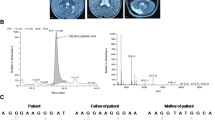Abstract
Combined D,L-2-hydroxyglutaric aciduria (DL-2HGA; OMIM #615182) is a rare neurometabolic disorder clinically characterized by muscular hypotonia, severe neurodevelopmental dysfunction, and intractable seizures associated with respiratory distress. Biochemically, DL-2HGA patients excrete increased amounts of D- and L-2-hydroxyglutarate (D2HG and L2HG, respectively), with predominance of D2HG, and α-ketoglutarate, and show a decrease in urinary citrate. Impaired function of the mitochondrial citrate carrier (CIC) due to pathogenic mutations within the SLC25A1 gene has been identified as the underlying molecular cause of the disease. CIC mediates efflux of the mitochondrial tricarboxylic acid (TCA) cycle intermediates citrate and isocitrate in exchange for cytosolic malate. Thus, depletion of cytosolic citrate as well as accumulation of citrate inside mitochondria have been considered to play a role in the pathophysiology of DL-2HGA. Here, we report for the first time on a patient with a genetically confirmed diagnosis of DL-2HGA and treatment with either malate or citrate. During malate treatment, urinary malate concentration increased, but beyond that, neither biochemical nor clinical alterations were observed. In contrast, treatment with citrate led to an increased urinary excretion of TCA cycle intermediates malate and succinate, and by trend to an increased concentration of urinary citrate. Furthermore, excretion of D2HG and L2HG was reduced during citrate treatment. Clinically, the patient showed stabilization with regard to frequency and severity of seizures. Treating DL-2HGA with citrate should be considered in other DL-2HGA patients, and its effects should be studied systematically.




Similar content being viewed by others
References
Chalmers RA, Lawson AM (1982) Organic acids in man. Chapman and Hall Ltd., London
Edvardson S, Porcelli V, Jalas C et al (2013) Agenesis of corpus callosum and optic nerve hypoplasia due to mutations in SLC25A1 encoding the mitochondrial citrate transporter. J Med Genet 50:240–245
Hagos Y, Krick W, Braulke T, Mühlhausen C, Burckhardt G, Burckhardt BC (2008) Organic anion transporters OAT1 and OAT4 mediate the high affinity transport of glutarate derivatives accumulating in patients with glutaric acidurias. Pflugers Arch 457:223–231
Kanungo S, Soares N, He M, Steiner RD (2013) Sterol metabolism disorders and neurodevelopment - an update. Dev Disabil Res Rev 17:197–210
Kranendijk M, Struys EA, Salomons GS, Van der Knaap MS, Jakobs C (2012) Progress in understanding 2-hydroxyglutaric acidurias. J Inherit Metab Dis 35:571–587
Lamp J, Keyser B, Koeller DM, Ullrich K, Braulke T, Mühlhausen C (2011) Glutaric aciduria type 1 metabolites impair the succinate transport from astrocytic to neuronal cells. J Biol Chem 286:17777–17784
Lund EG, Xie C, Kotti T, Turley SD, Dietschy JM, Russel DW (2003) Knockout of the cholesterol 24-hydroxylase gene in mice reveals a brain-specific mechanism of cholesterol turnover. J Biol Chem 278:22980–22988
McNally MA, Pyzik PL, Rubenstein JE, Hamdy RF, Kossoff EH (2009) Empiric use of potassium citrate reduces kidney-stone incidence with the ketogenic diet. Pediatrics 124:e300–e304
Mühlhausen C, Burckhardt BC, Hagos Y et al (2008) Membrane translocation of glutaric acid and its derivatives. J Inherit Metab Dis 31:188–193
Muntau AC, Röschinger W, Merkenschlager A et al (2000) Combined D-2- and L-2-hydroxyglutaric aciduria with neonatal onset encephalopathy: a third biochemical variant of 2-hydroxyglutaric aciduria? Neuropediatrics 31:137–140
Mycielska ME, Patel A, Rizaner N et al (2009) Citrate transport and metabolism in mammalian cells: prostate epithelial cells and prostate cancer. Bioessays 31:10–20
Nota B, Struys EA, Pop A et al (2013) Deficiency in SLC25A1, encoding the mitochondrial citrate carrier, causes combined D-2- and L-2-hydroxyglutaric aciduria. Am J Hum Genet 92:627–631
Palmieri F (2004) The mitochondrial transporter family (SLC25): physiological and pathological implications. Pflugers Arch 447:689–709
Read M-H, Bonamy C, Laloum D et al (2005) Clinical, biochemical, magnetic resonance imaging (MRI) and proton magnetic resonance spectroscopy (1H-MRS) findings in a fourth case of combined D- and L-2 hydroxyglutaric aciduria. J Inherit Metab Dis 28:1149–1150
Struys EA, Jansen EE, Verhoeven NM, Jakobs C (2004) Measurement of urinary D- and L-2-hydroxyglutarate enantiomers by stable-isotope-dilution liquid chromatography-tandem mass spectrometry after derivatization with diacetyl-L-tartaric anhydride. Clin Chem 50:1391–1395
Acknowledgments
We thank Dr. Uwe Ahting, Mitocenter, Institute of Human Genetics, Technische Universität, Munich, Germany, for providing the data of mitochondrial enzyme analyses, and Prof. Dr. Jens Fiehler, Department of Diagnostic and Interventional Neuroradiology, University Medical Center Hamburg-Eppendorf, Hamburg, Germany, for providing MRI images.
Conflict of interest
None.
Author information
Authors and Affiliations
Corresponding author
Additional information
Communicated by: Cornelis Jakobs
Rights and permissions
About this article
Cite this article
Mühlhausen, C., Salomons, G.S., Lukacs, Z. et al. Combined D2-/L2-hydroxyglutaric aciduria (SLC25A1 deficiency): clinical course and effects of citrate treatment. J Inherit Metab Dis 37, 775–781 (2014). https://doi.org/10.1007/s10545-014-9702-y
Received:
Revised:
Accepted:
Published:
Issue Date:
DOI: https://doi.org/10.1007/s10545-014-9702-y




